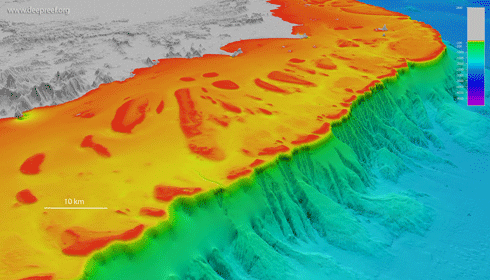
|
Published: 20 December 2010
Mapping the abyss
Captain James Cook might not have run into trouble if he had access to a new 3D map produced by a researcher at his namesake university.

|
|
A 3D view of the Cooktown region shows an ancient river channel several kilometres wide preserved in the seabed. Credit: Robin Beaman
|
Using data gathered from a wide range of sources, including multibeam and single-beam echo sounders, airborne laser bathymetry and satellite imagery, Dr Robin Beaman’s 3D depth model covers an area of three million square kilometres.
Covering the entire Queensland coast, Great Barrier Reef, and the Coral Sea almost to New Caledonia, the model shows seabed features down to 100 m in size and at up to 5000 m deep.
‘Previously we’ve had little understanding of what exists below 200 m, so it’s very exciting to be able to map from the coastline all the way down to the abyss, over five kilometres deep,’ says Dr Beaman.
Users of the publicly available maps can immerse themselves in vast underwater dune fields, observe a huge landslide over 20 km wide in the Cairns region, or see the extensive algal reefs on the northern Great Barrier Reef shelf. Of more immediate concern, the imagery also shows a huge rain of sand off Bundaberg, where the edge of the continental shelf is caving away.
Dr Beaman’s work has attracted interest from agencies around the world. The Australian Institute of Marine Science is using it for water quality tracking and hydrodynamic modelling, while other studies are examining the response of corals to wave movement.
‘It certainly gives you a sense of how dramatic the undersea landscape is, and how little we really know about it,’ Dr Beaman says.
More information:
View the maps at www.deepreef.org/bathymetry



